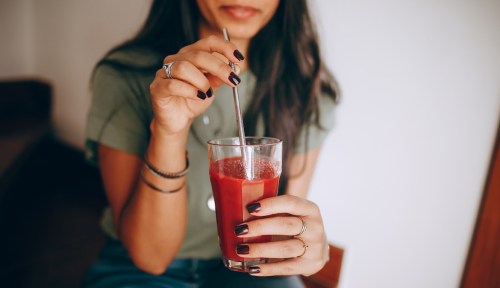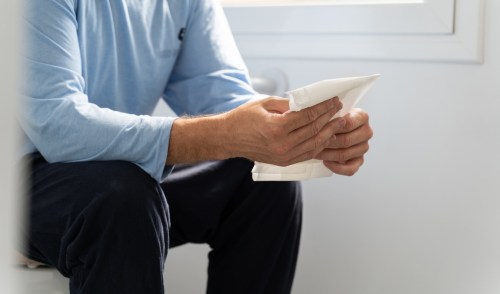If you’ve had a urinary tract infection (UTI) before, you’ve probably turned to home remedies—alongside antibiotics—to help prevent UTIs from ever returning. One of those remedies was likely cranberry juice.
Experts in This Article
registered dietitian and gut health expert
a registered dietitian specializing in gut health at the Princeton Longevity Center.
gastroenterologist, nutrition and lifestyle medicine specialist, and founder of Sarah Robbins MD
Turns out, the tart, red drink helps reduce bad bacteria in your urinary tract. But there are a number of other health benefits of cranberries, too. Namely: They have phytochemicals, which are antioxidants (specifically, anthocyanins and pelargonidin) shown to have an anti-cancer effect, and they may also reduce your risk of things like heart disease, per a November 2020 review in the Journal of the Science of Food and Agriculture1.
But does cranberry juice have a positive effect on your gut? More specifically, can cranberry juice help you poop?
We spoke with two registered dietitians and a gastroenterologist about cranberry juice’s effect on digestion, and got to the bottom of whether the tiny, tart fruit can act as a natural laxative.
Does cranberry juice make you poop?
In short—yes, it can. While cranberry juice isn’t the most effective natural laxative, there are several reasons it may help move things along. The first being hydration.
If you’re not a fan of plain water, cranberry juice can help you reach your hydration goals for the day. Because adequate hydration is key to having healthy and regular bowel movements, drinking cranberry juice to increase your fluid intake could help you poop, says Amanda Sauceda, RD, a gut health-focused dietitian.
“Cranberry juice is also a source of a natural sugar called fructose, which can have a mild laxative effect,” says Sarah Robbins, MD, gastroenterologist and founder of Well Sunday Health Corporation. A typical serving (8 ounces) will gently help your stool move through your GI tract.
But keep in mind, if you are particularly sensitive to fructose (like many people with IBS) or drink it in large quantities, it may have the opposite effect, causing diarrhea. Bottom line? Serving size is important.
Additionally, cranberry juice has a compound called salicylate, says Katie Breazeale, RD, a dietitian specializing in gut health at the Princeton Longevity Center. “Salicylate is known for increasing the healthy bacteria in the bowel,” she explains.
Beyond these healthy properties, simply drinking enough fluids—which can include 8 ounces of cranberry juice with water, herbal tea, and other hydrating beverages—and getting enough calories each day can help your large intestine contract, moving poop out of your system, Breazeale adds.
A tip: While cranberry juice has constipation-busting properties, it actually has significantly less fiber than whole cranberries, says Dr. Robbins. This means, drinking cranberry juice may not be as effective at treating constipation as eating whole cranberries and/or other high-fiber foods.
“Cranberry juice is a source of natural sugar called fructose, which can have a mild laxative effect.”—Sarah Robbins, MD, gastroenterologist
Can cranberry juice turn your poop red or black?
Technically, cranberry juice can cause your poop to look dark-reddish from its deep red pigment, says Dr. Robbins. But she mentions this isn’t common, and likely wouldn’t happen unless you’ve had lots of cranberry juice.
That said, if your poop color changes after drinking cranberry juice, it should go back to normal within 24 to 48 hours of drinking it, she adds.
If your stool appears black, however, this is not from cranberry juice. “Black stools can indicate bleeding in the upper gastrointestinal tract, such as from the stomach or upper small intestine,” says Dr. Robbins.
This condition—known as melena—is not typically from cranberry or other fruit juices, per the Cleveland Clinic. It may be caused by certain supplements, such as iron supplements or medications with bismuth like Pepto-Bismol, she adds. If you have black stool (that can be explained by medication or not), it’s best to see your doctor to investigate the cause, in case it’s due to internal bleeding, which is a serious symptom.
How much cranberry juice can you drink per day?
Adults should aim to get 1.5 to 2.5 cups of fruit per day, and up to one cup of that can be 100 percent juice, according to the U.S. Department of Agriculture. Breazeale suggest sticking close to 8 ounces (or less) of cranberry juice each day, as drinking too much could lead to things like diarrhea, blood sugar spikes, and stomach cramps.
When choosing cranberry juice, Dr. Robbins recommends choosing pure, unsweetened cranberry juice rather than cranberry juice cocktails or other drinks with added sugars.
There are also potential downsides to drinking too much cranberry juice, says Dr. Robbins, including the following:
- Even the natural sugars in 100 percent cranberry juice can add up and contribute to type 2 diabetes risks/complications and dental issues.
- Cranberry juice has oxalates, which can contribute to the formation of kidney stones in people susceptible to them, per the Medical College of Wisconsin.
Cranberry juice can also interact with certain medications, including blood thinners like warfarin. This is why it’s important to talk to your doctor before trying cranberry juice to relieve constipation, or drinking it on a regular basis, says Dr. Robbins.
Other ways to treat constipation
While cranberry juice could help move your bowels along, there are other natural remedies for constipation that may work even better, say Sauceda and Dr. Robbins. Some of these include:
Increase your fiber intake
“Fiber is your best bet for improving constipation because it helps bulk up and soften your poop, making it easier to pass,” says Sauceda. She recommends adding fiber to your diet slowly and gradually to allow your gut to get used to it and reduce the risk of side effects like gas and bloating.
Dr. Robbins also recommends incorporating both soluble and insoluble fiber into your diet, as foods with either can help you poop. Some foods high in soluble fiber include the following, per Mount Sinai:
- Oats
- Apples
- Flaxseeds
- Barley
- Lentils
- Beans
- Peas
Foods high in insoluble fiber include the following, per Mount Sinai:
- Wheat bran
- Vegetables like peppers, carrots, and leafy greens
- Whole grains like wheat bread, cereals, etc.
If you’re having a hard time getting enough fiber through your diet alone, Dr. Robbins suggests fiber supplements like psyllium husk, methylcellulose, or wheat dextrin. Always ask your doctor before trying them though, to see if they’re right for you.
Stay hydrated
Drinking enough water helps keep things moving through your gut, which can relieve constipation, says Sauceda. Aim to get anywhere from 11.5 to 15.5 cups of water per day, through drinking and eating hydrating foods, per the Mayo Clinic.
Getting enough fluid is especially important as you’re increasing your fiber intake, to help keep things moving, per Johns Hopkins Medicine.
Try an abdominal massage
Abdominal massage can help stimulate your colon and get stool moving, per Sauceda. She recommends starting by applying gentle pressure to the lower left side of your abdomen with your fingers, and moving your hand across to the right side.
Another method you can try includes the following steps, per Michigan Medicine:
- Lie down on your back with your knees bent.
- Lightly press down on the lower right side of your abdomen near your pelvic bone.
- Rub upward in a circular motion until you reach your ribs.
- Move across to the left side of your abdomen.
- Massage your way down toward the lower left abdomen.
- Repeat this clockwise circular massage for about 10 minutes.
Tweak the way you sit on the toilet
Turns out, your pooping position can make a huge difference in helping you have a bowel movement. Try elevating your knees above your hips, which can allow your body to relax while sitting on the toilet, says Sauceda. This position can be achieved by placing a small stool under your feet, to relieve any straining that comes with constipation, she adds.
You can also try rocking back and forth while you poop to help stimulate a bowel movement, per Yale Medicine.
Get some exercise
Getting daily movement can help move your bowels along. Try to aim for at least 30 minutes of moderate exercise most days of the week, per Dr. Robbins. This can include walking around your neighborhood, Pilates, yoga or stretching, or any other activity you enjoy.
While more studies are needed on why exactly exercise helps, current research supports exercise as a good natural treatment option for constipation, per a February 2019 meta-analysis in the Scandinavian Journal of Gastroenterology2.
Establish a bathroom routine
You may have a set bedtime routine or morning routine, but having a bathroom routine can help regulate your GI system, too.
“Try to go to the bathroom at the same time each day, ideally after meals, to take advantage of the body’s natural rhythms,” says Dr. Robbins. She says it’s important not to ignore the urge to “go,” as delaying bowel movements can lead to harder stools and worsen constipation.
Take a closer look at your meds
Certain medications can cause or worsen constipation, says Dr. Robbins. “If you suspect a medication is contributing to your constipation, talk to your doctor,” she recommends. If needed, they may be able to adjust your dosage or suggest an alternative medication.
Consider over-the-counter (OTC) laxatives
If any of the above lifestyle changes do not help, Dr. Robbins recommends trying OTC laxatives. This could include a supplement like Metamucil or Benefiber, or a stimulant laxative like Miralax. Since most laxatives shouldn’t be used long-term, read the labels carefully, and check with your doctor before taking them, to see if it’s right for you.
When to see a doctor about constipation or gut issues
While occasional constipation is common and usually manageable with diet and lifestyle adjustments, certain situations warrant medical attention, says Dr. Robbins. Some signs you should go to the doctor about constipation include the following:
- If constipation lasts three weeks or more or is severe and not relieved by over-the-counter treatments and lifestyle changes
- If you notice bright red blood in your poop or on the toilet paper after a bowel movement. This can indicate hemorrhoids or more serious conditions like inflammatory bowel disease (IBD) or intestinal bleeding
- If you notice black stools (aka melena), which can indicate internal bleeding
- If you’ve lost weight without trying
- If you have significant abdominal pain or discomfort
- If you have sudden changes in bowel habits
- If you have a family history of gut diseases, like colorectal cancer or IBD
- If you have anemia or other nutritional deficiencies
- If you have symptoms of bowel obstruction, like vomiting, severe abdominal pain, and inability to pass gas or stools—this is considered a medical emergency and should prompt a visit to the ER
If you have any of the above symptoms, it’s important to reach out to your doctor to rule out serious causes.
The bottom line
Cranberry juice is often used as a UTI prevention method or at-home UTI remedy. It also has several other health benefits due to its antioxidant content. Cranberry juice may even have a mild laxative effect from its natural sugars and contribution to your overall fluid intake.
That said, there are other fruits that are better natural laxatives, like prunes or prune juice, for example. So if you’re dealing with constipation discomfort and need quick relief, maybe skip the cranberries and try other methods like walking, abdominal massage, and water.
FAQ
Does cranberry juice make you have diarrhea?
For some people, cranberry juice can cause diarrhea. This can be from sugar alcohol in some types of juice, which can lead to an upset stomach and loose stool. Even natural sugar like fructose can trigger diarrhea in some people, including those with IBS.
To prevent this, it’s best to stick with a serving size of cranberry juice—8 ounces—and talk to your doctor if your diarrhea continues or comes with other concerning symptoms like vomiting or fainting.
When should you not drink cranberry juice?
People susceptible to kidney stones should limit or avoid cranberry juice because it has oxalates—an ingredient naturally found in certain foods that bind to calcium in your kidneys, leading to the formation of kidney stones. Other foods high in oxalates include leafy greens, potatoes, soy, and almonds, per Colorado State University.
And if you take certain medications, like anti-coagulants (blood thinners), you should not drink cranberry juice unless given the “okay” from your doctor.
—reviewed by Jennifer Logan, MD, MPH
Zhao, Shaomin et al. “American cranberries and health benefits – an evolving story of 25 years.” Journal of the science of food and agriculture vol. 100,14 (2020): 5111-5116. doi:10.1002/jsfa.8882
↩︎Blumberg, Jeffrey B et al. “Impact of Cranberries on Gut Microbiota and Cardiometabolic Health: Proceedings of the Cranberry Health Research Conference 2015.” Advances in nutrition (Bethesda, Md.) vol. 7,4 759S-70S. 15 Jul. 2016, doi:10.3945/an.116.012583
↩︎Gao R, Tao Y, Zhou C, Li J, Wang X, Chen L, Li F, Guo L. Exercise therapy in patients with constipation: a systematic review and meta-analysis of randomized controlled trials. Scand J Gastroenterol. 2019 Feb;54(2):169-177. doi: 10.1080/00365521.2019.1568544. Epub 2019 Mar 7. PMID: 30843436.
↩︎
Sign Up for Our Daily Newsletter
Get all the latest in wellness, trends, food, fitness, beauty, and more delivered right to your inbox.
Got it, you've been added to our email list.











